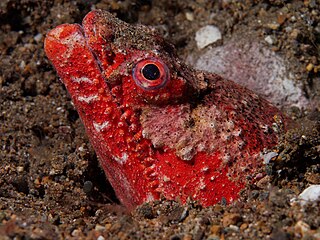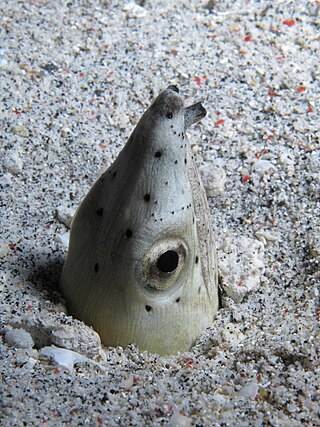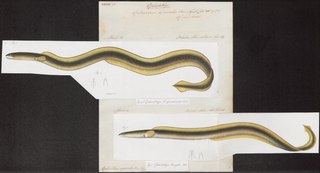
Brachysomophis is a genus of eels in the snake eel family Ophichthidae.
The Johnston snake eel, also known as the peppered worm eel in Micronesia and Hawaii is an eel in the family Ophichthidae. It was described by Leonard Peter Schultz and Loren Paul Woods in 1949. It is a marine, tropical eel, which is known from the Indo-Pacific region, including the Chagos Islands, Hawaii, the Marquesan Islands, the Society Islands, Australia, and New Caledonia. It dwells at a depth range of 2–23 m, and inhabits sand sediments in coral reefs. It can reach a maximum total length of 35 cm.
The deepwater big-eyed worm eel is an eel in the family Ophichthidae. It was described by John E. McCosker in 2006. It is a subtropical, marine eel which is known from New Zealand, in the southwestern Pacific Ocean. It dwells at a depth range of 425–820 metres. Females can reach a maximum total length of 58 centimetres.
Brachysomophis atlanticus is an eel in the family Ophichthidae. It was described by Jacques Blache and Luiz Vieria Caldas Saldanha in 1972. It is a tropical, marine eel which is known from the eastern Atlantic Ocean, including Senegal and the Gulf of Guinea. It inhabits the continental shelf, and makes burrows in sand and mud. Males can reach a maximum total length of 27.3 centimetres.

The reptilian snake eel, also known as Henshaw's snake eel, the Hawaiian crocodile eel or the crocodile snake eel, is an eel in the family Ophichthidae. It was described by David Starr Jordan and John Otterbein Snyder in 1904.
Brachysomophis longipinnis is an eel in the family Ophichthidae. It was described by John E. McCosker and John Ernest Randall in 2001. It is a marine, temperate water-dwelling eel which is known from a single specimen collected from Taiwan, in the northwestern Pacific Ocean. It is known to dwell at a depth of 50 metres, and is known to reach a total length of 42.1 centimetres.
Brachysomophis porphyreus is an eel in the family Ophichthidae. It was described by Coenraad Jacob Temminck and Hermann Schlegel in 1846. It is a marine, temperate water-dwelling eel which is known from the northwestern Pacific Ocean, including Taiwan, China, Japan, and Korea. It is known to dwell at a depth of 20 metres, and makes burrows in mud, nearly deep enough to cover itself completely. Males can reach a maximum total length of 130 centimetres.
The turret snake eel is an eel in the family Ophichthidae. It was described by John E. McCosker and John Ernest Randall in 2001. It is a marine, tropical eel which is known from the Indo-Western Pacific, including Indonesia and the Philippines. It dwells at a depth range of 14 to 18 metres, and inhabits sand and reefs. Males can reach a maximum total length of 13.9 centimetres (5.5 in).
The Finned worm eel is an eel in the family Ophichthidae. It was described by Coenraad Jacob Temminck and Hermann Schlegel in 1846. It is a marine, tropical eel which is known from the Indo-Pacific, including East Africa, the Society Islands, and southern Japan. It is known to dwell in reefs. It is the only worm eel in its region which possesses pectoral fins. Males can reach a maximum total length of 60 centimetres.
The Oriental worm-eel, also known as the Oriental snake eel, the Oriental sand-eel or the finny sand-eel, is an eel in the family Ophichthidae. It was described by John McClelland in 1844, originally under the genus Dalophis. It is a tropical, marine and freshwater-dwelling eel which is known from the Indo-Western Pacific, including Somalia, South Africa, India, Papua New Guinea, Tahiti, French Polynesia, Indonesia, Oman, Palau, New Caledonia, the Philippines, Sri Lanka, Seychelles, and Vanuatu. It dwells at a depth range of 0 to 3 metres, and forms burrows in sand and mud sediments in estuaries, rivers, and inshore turbid waters. Males can reach a maximum total length of 36 centimetres (14 in), but more commonly reach a TL of 25 centimetres (9.8 in).

The saddled snake-eel is an eel in the family Ophichthidae. It was described by George Tradescant Lay and Edward Turner Bennett in 1839, originally under the genus Ophisurus. It is a marine, tropical eel which is known from the Indo-Pacific and southeastern Atlantic Ocean, including East and South Africa, the Hawaiian Islands, the Marquesan Islands, the Mangaréva islands, Japan, and Australia. It dwells at a depth range of 0 to 70 metres, most often around 0 to 10 metres, and inhabits lagoons and reefs, in which it forms burrows in beds of seagrass and sandy areas. Males can reach a maximum total length of 66 centimetres (2.17 ft).

The goldspotted eel, also known as the goldspotted snake eel or the dark-spotted snake eel, is an eel in the family Ophichthidae. It was described by Charles Alexandre Lesueur in 1825, originally under the genus Muraenophis. It is a marine, tropical eel which is known from the western and eastern Atlantic Ocean, including Bermuda, southern Florida, USA; the Bahamas, Santa Catarina, and Brazil. It dwells at a maximum depth of 15 metres (49 ft), and inhabits rocky and coral reefs. Males can reach a maximum total length of 110 centimetres (3.6 ft).

The spotted snake eel, also known as the tiger snake eel or the spotted tiger snake eel, is an eel in the family Ophichthidae. It was described by Charles Frédéric Girard in 1859. It is a marine, tropical eel which is known from the eastern central and southeastern Pacific Ocean, including Chile, Costa Rica, Colombia, El Salvador, Ecuador, Mexico, Guatemala, Nicaragua, Panama, Honduras, and Peru. It dwells at a depth range of 0 to 60 metres, and inhabits benthic sediments of mud and sand. Males can reach a maximum total length of 74 centimetres (29 in), but more commonly reach a TL of 60 centimetres (24 in).

The highfin snake eel (Ophichthus altipennis, also known as the blackfin snake eel or the black-finned snake eel, is an eel in the family Ophichthidae. It was described by Johann Jakob Kaup in 1856, originally under the genus Microdonophis. It is a marine, tropical eel known from the eastern Indian Ocean and northwestern and western central Pacific Ocean, including Australia, French Polynesia, Indonesia, Japan, the Marshall Islands, Malaysia, the Philippines, and Papua New Guinea. It dwells at a depth range of 0 to 40 m, and forms burrows in soft inshore sand sediments. Males can reach a maximum total length of 103 cm.

The bluntnose snake eel is an eel in the family Ophichthidae. The author of the species is anonymous, but it has been referred to Edward Turner Bennett in 1830. It is a tropical, marine eel which is known from the Indo-Pacific, including Kenya, Madagascar, South Africa, Taiwan, Thailand, and the Philippines. It dwells at a maximum depth of 22 m, but also frequents shores. Males can reach a maximum total length of 45 cm.

The dark-shouldered snake eel is an eel in the family Ophichthidae. It was described by Pieter Bleeker in 1864. It is a tropical, marine eel which is known from the Pacific Ocean, including the East Indies, the Society Islands, the Mariana Islands, Queensland, the Marshall Islands, Micronesia, Japan, and India. It dwells at a depth range of 2–15 metres, and inhabits reefs. It forms burrows in mud and sand, and forages during the night. Males can reach a maximum total length of 115 centimetres.

The many-eyed snake eel is a species of eel in the family Ophichthidae. It was described by Pieter Bleeker in 1864. It is a tropical, marine and freshwater-dwelling eel which is known from the Indo-Pacific, including East Africa and the Hawaiian Islands. It dwells at a depth of 2 to 25 metres, and inhabits sand and rubble sediments near coral reefs. Males can reach a total length of 62.5 centimetres (24.6 in).

The punctuated snake eel is an eel in the family Ophichthidae. It was described by Achille Valenciennes in 1837, originally under the genus Ophisurus. It is a marine, subtropical eel which is known from the eastern central and southeastern Pacific Ocean, including Nicaragua, Chile, Colombia, Costa Rica, Ecuador, Peru, and Panama. It dwells at a depth range of 15 to 277 metres, and inhabits sand and mud sediments. Males can reach a maximum total length of 85 centimetres (33 in), but more commonly reach a TL of 60 centimetres (24 in).

The rice-paddy eel is an eel in the family Ophichthidae. It was described by Francis Buchanan-Hamilton in 1822, originally in the genus Ophisurus. It is a tropical, marine eel which is known from the Indo-West Pacific, including Somalia, Tanzania, South Africa, India, Pakistan, Sri Lanka, Indonesia, Polynesia, Australia, Bangladesh, Cambodia, Kenya, Madagascar, the Philippines, Malaysia, Mozambique, Seychelles, Saudi Arabia, Taiwan, China, Thailand, Vietnam, and southern Yemen. It is an anadromous species and spawns in freshwater, often in rice paddies during the rainy season, earning it its common name. It also spends time in lagoons, estuaries and coastal rivers, in which it lives in burrows in the river bottom and bank. Males can reach a maximum total length (TL) of 100 centimetres, but more commonly reach a TL of 70 cm.

The Marble-toothed snake-eel is an eel in the family Ophichthidae. It was described by Charles Henry Gilbert in 1898. It is a marine, tropical eel which is known from the eastern central and southeastern Pacific Ocean, including Costa Rica, Colombia, Panama and Ecuador. It dwells in shallow waters at a maximum depth of 10 metres (33 ft), and inhabits sand and mud sediments and mangroves. Males can reach a maximum total length of 68 centimetres (27 in).











